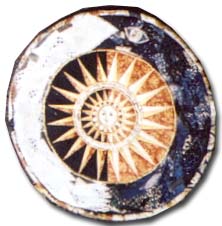an art show
I was invited by the well known art critic, Raghav Shreyas to attend an opening of an art exhibition/auction to be held in the Time and Space art gallery. For the past month or so I have been trying to fill in some rather enormous gaps in my knowledge of art and especially with regard to paining. So I thought that it would be a wonderful opportunity to experience art in its natural habitat - an art gallery. And Since R had deigned to be my intrepid native guide, I had no doubts that I was in for a good time. The gallery is located on one of the more picturesque roads in Bangalore- Lavelle road, and there's just an easily missable small sign outside, on the high white walls. Almost as if to say, if you don't know where it is, you obviously don't belong. I definitely knew I didn’t belong, I didn’t even know what mental equipment to carry when venturing into the 'art world'. We went in just as the MC was finishing his plea for sales: the proceeds from the show were destined to support a charity in aid of better school infrastructures. As we went in, the organizers got a small girl to say a few words about the benefits of said charity. The kid spoke in Kannada , and the MC translated it for the behalf of the milling crowd. That was the first time that I have heard Kannada being translated in Bangalore, and naturally tried to see if the translation matched the original. There already seemed to be two layers: the kid was very obviously speaking a prepared text and the MC was putting his own spin while translation. While it didn’t depart too far from the original, the choice of certain words was intriguing. Meanwhile, RS introduced me to one of India’s hottest (and youngest) artists, who apparently sells everything he paints. So naturally I asked the guy where his painting was hung, and he went off on a tangent of exaggerated modesty saying that he didn’t want me to see it. I quite bluntly told him that since I was a scientist, it shouldn’t matter what I think of it, and then he immediately said -oh over there.
The show, though I’ve never been to one of these before, was utterly familiar to me. I have read countless descriptions of these sorts of events, and it all came to life in front of me. The signs were everywhere- hovering wine bearers, waiters with miniature snacks delicately stabbed with toothpicks, the bright lights and the vapid Kenny G music wafting around. The denizens of this world were crowds of artists and art critics and buyers- all elegantly dressed, and all employing theatrical gestures and statements. One of the art critics pointed out to me that you can differentiate artists from art critics based on the way they trim their beards (if they're men): the artists let their beards grow. The buyers are very easy to identify- they look at the price before they look at the painting.
Since the exhibition held pieces from the entire history of Indian art, I saw a bewildering variety of styles. Since I was still of the "I know what I like" school of thought, I tried to pick RS's brain to see what he sees in paintings that seemed no more than childish scrawls to me. He explained that the so called childishness is deliberately used in the painting and this is what that implies that there is more to the painting than what one immediately sees. I went around making a list- a top ten list, like I do with books. I had only one criterion: a painting that keeps me in front of it for a long time has higher status than one that doesn’t. So this took care of all the "deliberately naive" paintings, and I quickly compiled a list. I wish I could talk about these, but I just can't: for the past month I’ve been trying to understand the words of my newspaper's in house art critic, and it has till now been like reading a description of wine from those fabled wine tasters. They use words that have entirely different meanings for me. And this was the same problem. The critics are trying to describe a "something" that they derive from the painting and the only way they can do so is by employing words that have acquired jargon status in their line of work. Its also the same in every other field. Talk to high end physicist about his work and soon he will not be able to use normal English anymore, because these words simply don't suit. This rigidification of the words essentially ends up as a pretty profound barrier that a casual layman is unable to transcend. Even to speak about it, one must devote effort and time. While in science, the science writer acts somehow like a bridge between the worlds, in art, the art critic furthers enhances the barrier. Which leads me back to the conclusion that the art world is very self contained and functions because of a series of reciprocal links in a simple system consisting of just three players: Artists, Art critics and Buyers.
Later that night I went back to read the art critic's article about this show and was pleased to find that several of my top ten list were singled out for praise. I don't know if that means anything.




<< Home